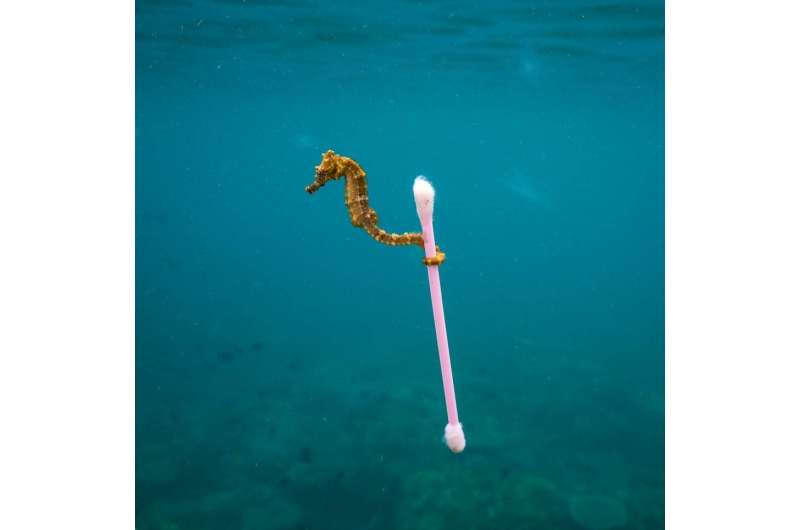Oceans: They pollute, they pay

In an effort to combat ocean plastic pollution, the EU has just adopted ambitious new legislation targeting ten of the most common single-use plastic products washing up on beaches and imposing greater responsibility on plastic manufacturers for their clean-up
Plastic pollution from single-use items such as straws, cutlery and cotton bud sticks are a serious issue facing oceans and marine life. Often, these items are not disposed of properly, and because they do not degrade, they end up in the oceans. Here, they absorb and concentrate toxins, and are eaten by wildlife, causing physical harm, starvation and death.
In response to this issue, initiatives like the Cotton Bud Project in the U.K.—a collaboration of conservation societies, NGOs and governments—aim to raise awareness of the problem and change consumer habits, such as flushing cotton buds and other sanitary waste down toilets.
However, the Cotton Bud Project and others readily admit that awareness campaigns have a limited success rate and more needs to be done in order to curb the problem entirely, including alternatives and strict legislation on single use plastics.
The Council of the EU adopted measures that include an EU-wide ban on plastic cotton bud sticks, cutlery, plates, straws, stirrers, sticks for balloons, all products made of oxo-plastic, plastic cups, and food and beverage containers made of expanded polystyrene.
It also lays out new rules for labeling products containing plastics, the percentage of recycled material new products must contain, providing alternatives to single-use items at point of sale and ensuring that they are not provided free of charge.
Along with these market restrictions, the legislation includes extended producers responsibilities (EPRs). These EPRs are based on the "polluter pays" principle, which simply means that manufactures of these products are responsible to help with clean-up and recycling.
Producers of the following products will need to help cover the costs of waste management and clean-up, as well as data gathering and awareness raising measures: food and beverage containers, bottles, cups, packets and wrappers, lightweight carrier bags and tobacco products with filters. Within these EPRs are also specific targets for the separate collection of single-use plastic beverage bottles: it calls for achieving 77 percent of targets by 2025, followed by increases to 90 percent by 2029.
Georg Mehlhart, senior researcher at the Öko-Institut (Institute for Applied Ecology), Germany, says these EPRs are "a much more important signal to the world and Europe than the ban of the 10 single-use products." Mehlhart believes that with the advances in recycling technology and new restrictions on the export of waste, the time is right for a change: "I cannot understand why corporations are allowed to place these products in the market with no collection scheme in place. This is a good example of governance saying that if producers place single-use plastic in the world, they are responsible, and the state is responsible to put in place the producer responsibility to schemes."
According to Ioana Popescu of the Rethink Plastic, an alliance of European NGOs, another important aspect of these news rules is that the scope of the directive doesn't differentiate between plastic products. For example, biodegradable and bio-based plastics will be governed by the new rules, as well.
The reason behind this is largely due to the variability in degradation conditions. "There are different environments in which a product might degrade, but you can't ensure that if will degrade in all of them," Popescu explains. "So when this product doesn't end up where it supposed to go, it will have the same effect as a normal plastic product." She also cautions that if these products are not composed of 100 percent biodegradable materials, they can still contribute to micro-plastics pollution.
There are therefore several considerations the plastic alternative industry will need to address, such as how products degrade. For bioplastics—plastic products sourced from renewable material—proper collection schemes are still required, as well. The energy costs and the carbon footprint of manufacturing plastic alternatives are important issues, and there are a growing number of what Mehlhart calls "green-green conflicts" in which the solution to one environmental issue—plastic pollution, for example—leads to the creation of another; in this case, the greenhouse gases emitted to make certain plastic alternatives.
Importantly, the legislation also places new rules on lost or forgotten fishing gear, which is a major source of marine pollution and threat to sea life, especially large fish and mammals. The directive states that EPR schemes covering the collection of waste fishing gear must be in place by 2024 and member states will set national collection targets and monitor fishing gear with the intent to eventually implement EU-wide targets. Finally, work will be launched on standards for designing fishing equipment that is easier to reuse and recycle.
Provided by Youris.com




















